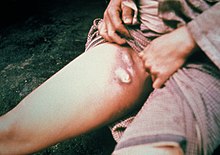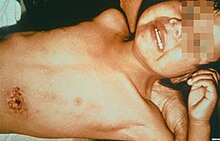Plague (disease)
| Plague | |
|---|---|
fluoroquinolone[3] | |
| Prognosis | ≈10% risk of death (with treatment)[4] |
| Frequency | ≈600 cases a year[2] |
Plague is an
The bubonic and septicemic forms are generally spread by
Those at high risk may be
Globally, about 600 cases are reported a year.
Signs and symptoms
There are several different clinical manifestations of plague. The most common form is bubonic plague, followed by septicemic and pneumonic plague.[6] Other clinical manifestations include plague meningitis, plague pharyngitis, and ocular plague.[6][7] General symptoms of plague include fever, chills, headaches, and nausea.[1] Many people experience swelling in their lymph nodes if they have bubonic plague.[1] For those with pneumonic plague, symptoms may (or may not) include a cough, pain in the chest, and haemoptysis.[1]
Bubonic plague

When a flea bites a human and contaminates the wound with regurgitated blood, the plague-causing bacteria are passed into the tissue. Y. pestis can reproduce inside cells, so even if
Y. pestis spreads through the
If the lymph node is overwhelmed, the infection can pass into the bloodstream, causing secondary septicemic plague and if the lungs are seeded, it can cause secondary pneumonic plague.[12]
Septicemic plague

Lymphatics ultimately drain into the bloodstream, so the plague bacteria may enter the blood and travel to almost any part of the body. In
Pneumonic plague
The
Cause

Transmission of Y. pestis to an uninfected individual is possible by any of the following means:[18]
- droplet contact – coughing or sneezing on another person
- Direct physical contact;– touching an infected person, including sexual contact
- indirect contact – usually by touching soil contamination or a contaminated surface
- airborne transmission – if the microorganism can remain in the air for long periods
- fecal-oral transmission – usually from contaminated food or water sources
- vector borne transmission– carried by insects or other animals.
Yersinia pestis circulates in animal reservoirs, particularly in rodents, in the natural foci of infection found on all continents except Australia. The natural foci of plague are situated in a broad belt in the tropical and sub-tropical latitudes and the warmer parts of the temperate latitudes around the globe, between the parallels 55° N and 40° S.[18] Contrary to popular belief, rats did not directly start the spread of the bubonic plague. It is mainly a disease in the
A 21st-century study of a 1665 outbreak of plague in the village of Eyam in England's Derbyshire Dales – which isolated itself during the outbreak, facilitating modern study – found that three-quarters of cases are likely to have been due to human-to-human transmission, especially within families, a much bigger proportion than previously thought.[20]
Diagnosis
Symptoms of plague are usually non-specific and to definitively diagnose plague, laboratory testing is required.[21] Y. pestis can be identified through both a microscope and by culturing a sample and this is used as a reference standard to confirm that a person has a case of plague.[21] The sample can be obtained from the blood, mucus (sputum), or aspirate extracted from inflamed lymph nodes (buboes).[21] If a person is administered antibiotics before a sample is taken or if there is a delay in transporting the person's sample to a laboratory and/or a poorly stored sample, there is a possibility for false negative results.[21]
Polymerase chain reaction (PCR) may also be used to diagnose plague, by detecting the presence of bacterial genes such as the pla gene (plasmogen activator) and caf1 gene, (F1 capsule antigen).[21] PCR testing requires a very small sample and is effective for both alive and dead bacteria.[21] For this reason, if a person receives antibiotics before a sample is collected for laboratory testing, they may have a false negative culture and a positive PCR result.[21]
Blood tests to detect antibodies against Y. pestis can also be used to diagnose plague, however, this requires taking blood samples at different periods to detect differences between the acute and convalescent phases of F1 antibody titres.[21]
In 2020, a study about rapid diagnostic tests that detect the F1 capsule antigen (F1RDT) by sampling sputum or bubo aspirate was released.[21] Results show rapid diagnostic F1RDT test can be used for people who have suspected pneumonic and bubonic plague but cannot be used in asymptomatic people. F1RDT may be useful in providing a fast result for prompt treatment and fast public health response as studies suggest that F1RDT is highly sensitive for both pneumonic and bubonic plague. However, when using the rapid test, both positive and negative results need to be confirmed to establish or reject the diagnosis of a confirmed case of plague and the test result needs to be interpreted within the epidemiological context as study findings indicate that although 40 out of 40 people who had the plague in a population of 1000 were correctly diagnosed, 317 people were diagnosed falsely as positive.[21][22][23]
Prevention
Vaccination
Bacteriologist
Since human plague is rare in most parts of the world as of 2023, routine vaccination is not needed other than for those at particularly high risk of exposure, nor for people living in areas with
Early diagnosis
Diagnosing plague early leads to a decrease in transmission or spread of the disease.[21]
Prophylaxis
Pre-exposure prophylaxis for first responders and health care providers who will care for patients with pneumonic plague is not considered necessary as long as standard and droplet precautions can be maintained.[7] In cases of surgical mask shortages, patient overcrowding, poor ventilation in hospital wards, or other crises, pre-exposure prophylaxis might be warranted if sufficient supplies of antimicrobials are available.[7]
Postexposure prophylaxis should be considered for people who had close (<6 feet), sustained contact with a patient with pneumonic plague and were not wearing adequate personal protective equipment.[7] Antimicrobial postexposure prophylaxis also can be considered for laboratory workers accidentally exposed to infectious materials and people who had close (<6 feet) or direct contact with infected animals, such as veterinary staff, pet owners, and hunters.[7]
Specific recommendations on pre- and post-exposure prophylaxis are available in the clinical guidelines on treatment and prophylaxis of plague published in 2021.[7]
Treatments
If diagnosed in time, the various forms of plague are usually highly responsive to antibiotic therapy.
The plague bacterium could develop drug resistance and again become a major health threat. One case of a drug-resistant form of the bacterium was found in Madagascar in 1995.[30] Further outbreaks in Madagascar were reported in November 2014[31] and October 2017.[32]
Epidemiology

Globally about 600 cases are reported a year.
In 2022 the possible origin of all modern strands of Yersinia pestis DNA was found in human remains in three graves located in
Biological weapon
The plague has a long history as a
In 1347, the
During
Ishii innovated bombs containing live mice and fleas, with very small explosive loads, to deliver the weaponized microbes, overcoming the problem of the explosive killing the infected animal and insect by the use of a ceramic, rather than metal, casing for the warhead. While no records survive of the actual usage of the ceramic shells, prototypes exist and are believed to have been used in experiments during WWII.[37][38]
After World War II, both the United States and the Soviet Union developed means of weaponising pneumonic plague. Experiments included various delivery methods, vacuum drying, sizing the bacterium, developing strains resistant to antibiotics, combining the bacterium with other diseases (such as diphtheria), and genetic engineering. Scientists who worked in USSR bio-weapons programs have stated that the Soviet effort was formidable and that large stocks of weaponised plague bacteria were produced. Information on many of the Soviet and US projects is largely unavailable. Aerosolized pneumonic plague remains the most significant threat.[39][40][41]
The plague can be easily treated with antibiotics. Some countries, such as the United States, have large supplies on hand if such an attack should occur, making the threat less severe.[42]
See also
- Timeline of plague
References
- ^ a b c d e f g h i "Symptoms Plague". CDC. September 2015. Retrieved 8 November 2017.
- ^ a b c d e f g h i j k l m n o p q r s t "Plague". World Health Organization. October 2017. Retrieved 8 November 2017.
- ^ a b "Resources for Clinicians Plague". CDC. October 2015. Retrieved 8 November 2017.
- ^ a b "FAQ Plague". CDC. September 2015. Retrieved 8 November 2017.
- ^ "Transmission Plague". CDC. September 2015. Retrieved 8 November 2017.
- ^ PMID 32435802.
- ^ PMID 34264565.
- PMID 198377.
- PMID 16567636.
- ^ "Symptoms | Plague". Centers for Disease Control and Prevention. 14 September 2015. Retrieved 18 April 2017.
- PMID 15855643.
- ^ "Plague". Centers for Disease Control and Prevention. Retrieved 2014-08-05.
- ^ Wagle PM (1948). "Recent advances in the treatment of bubonic plague". Indian J Med Sci. 2: 489–94.
- PMID 14774219.
- PMID 29014753.
- ISBN 978-0-8385-8529-0.
- PMID 7386958.
- ^ a b Plague Manual: Epidemiology, Distribution, Surveillance and Control, pp. 9, 11. WHO/CDS/CSR/EDC/99.2
- ^ Yersin A (1894). "La peste bubonique à Hong-Kong". Annales de l'Institut Pasteur. 8: 662–67.
- ^ Greig Watson (22 April 2020). "Coronavirus: What can the 'plague village of Eyam teach us?". BBC News.
- ^ PMID 32597510.
- S2CID 234804227.
- ^ WHO Guidelines for Plague Management. World Health Organization. 2021. pp. 1–19.
- ^ a b "Waldemar Haffkine: The vaccine pioneer the world forgot". BBC News. 2020-12-11. Retrieved 2021-01-20.
- ^ "WALDEMAR MORDECAI HAFFKINE". Haffkine Institute. Retrieved 2021-01-20.
- S2CID 42075270.
- ^ "Plague Vaccine". CDC. June 11, 1982. Retrieved Apr 30, 2015.
- PMID 10796565.
- PMID 16447105.
- ^ Drug-resistant plague a 'major threat', say scientists, SciDev.Net.
- ^ "Plague – Madagascar". World Health Organization. 21 November 2014. Archived from the original on November 23, 2014. Retrieved 26 November 2014.
- ^ "WHO scales up response to plague in Madagascar". World Health Organization (WHO). 1 October 2017. Retrieved 5 October 2017.
- ^ "Origin of Black Death finally found in bacteria from Kyrgyzstan graves".
- ^ Schama, S. (2000). A History of Britain: At the Edge of the World? 3000 BC-AD 1603, BBC Worldwide, London, p. 226.
- PMID 12194776.
- ^ Daniel Barenblatt, A Plague upon Humanity, HarperCollins, 2004, pp. 220–221
- ^ "Japan's Secret Biological Weapons Program". Damn Interesting. Retrieved 2020-05-29.
- ^ Chen B (September 17, 2013). "New evidence of Japan's Unit 731 bio-warfare". China.org.cn. Retrieved 29 August 2020.
- ^ "Plague". Johns Hopkins Center for Public Health Preparedness. The Johns Hopkins University. Retrieved 29 August 2020.
- ISBN 9781455737550.
- PMID 16200159.
- ISBN 9780803625051.
Further reading
- Nelson CA, Meaney-Delman D, Fleck-Derderian S, Cooley KM, Yu PA, Mead PS (July 2021). "Antimicrobial Treatment and Prophylaxis of Plague: Recommendations for Naturally Acquired Infections and Bioterrorism Response" (PDF). MMWR Recomm Rep. 70 (3): 1–27. (PDF) from the original on 2022-10-09.
External links
- WHO Health topic
- CDC Plague map world distribution, publications, information on bioterrorism preparedness and response regarding plague
- Symptoms, causes, pictures of bubonic plague
